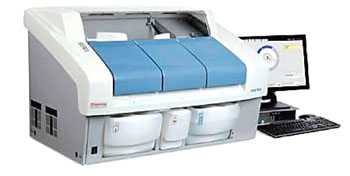Dried Blood Spot Sampling Used for HbA1c Measurement
By LabMedica International staff writers
Posted on 29 Sep 2015
The use of dried blood spot (DBS) sampling is an alternative to traditional venous blood collection, and particularly useful for people living in rural and remote areas, and for those who are infirm, house-bound or time-poor.Posted on 29 Sep 2015
Glycated hemoglobin (HbA1c) is a biomarker that is fundamental for the diagnosis of diabetes and for monitoring glycemic control and traditionally its measurement depends on venipuncture, and on processing, transportation and storage of whole blood (WB) samples, which can be logistically challenging.

Image: Indiko Plus Clinical and Specialty Chemistry fully automated analyzer (Photo courtesy of Thermo Fisher Scientific).
Scientists at The Australian National University (Canberra, Australia) collected venous and capillary blood samples from 115 adult participants. After proper instruction, each participant punctured his/her own finger and collected capillary blood samples on pieces of a proprietary cellulose filter paper. Each filter paper was subsequently placed inside a breathable envelope, stored at room temperature, and processed on the same day (D0), four (D4), seven (D7) and fourteen (D14) days after collection.
HbA1c levels were measured in duplicates/triplicates in whole venous blood (WB), capillary blood (capDBS) and venous blood placed on the matrix paper (venDBS) and determined by a direct turbidimetric inhibition immunoassay that determines HbA1c as a percentage of total hemoglobin (%HbA1c). Assays were performed on an Indiko Plus (Thermo Fisher Scientific; Waltham, MA USA) automated biochemistry analyzer, and results were reported as %HbA1c National Glycohemoglobin Standardization Program (NGSP) values.
Eleven and 56 patients had type 1 and type 2 diabetes mellitus, respectively. Overall mean whole blood HbA1c levels were 6.22 ± 1.11%, 5.41 ± 0.35% for participants without diabetes, 7.80 ± 0.81% for volunteers with type 1 diabetes, and 6.61 ± 1.11% among individuals with type 2 diabetes. Mean ± SD capillary DBS (capDBS) levels of HbA1c were 6.62 ± 1.16% when measured on D0, 6.92 ± 1.32% on D4, 6.85 ± 1.29% on D7, and 6.62 ± 1.44% on D14. Venous DBS samples ranged from 6.72 ± 1.20% on D0 to 7.36 ± 1.47% on D7. Results from capDBS and venDBS showed high correlation and agreement to WB results, except for results from D14 samples.
The authors concluded the measurement of HbA1c from DBS samples provided results that were comparable to results from WB samples, if measured up to seven days after collection. Intra-assay coefficients of variation were low, results were in agreement with the gold-standard, and prediction intervals were clinically acceptable. The measurement of HbA1c through DBS sampling may be considered in situations where traditional venipuncture is not available. The study was published on July 8, 2015, in the journal BMC Clinical Pathology.
Related Links:
The Australian National University
Thermo Fisher Scientific













